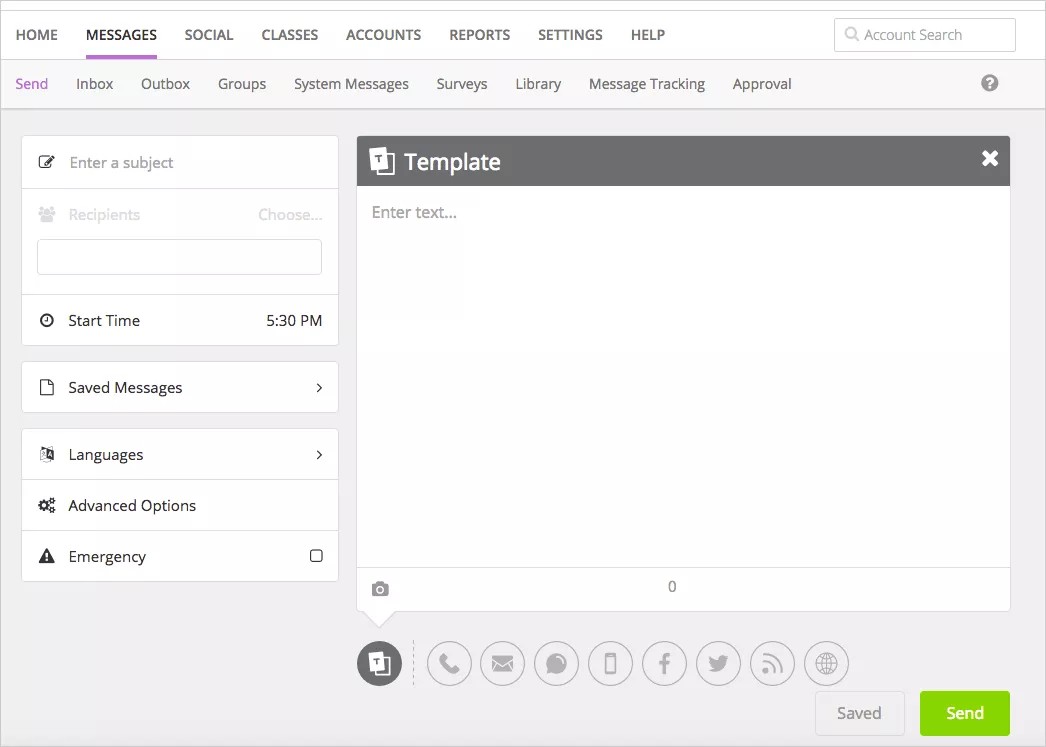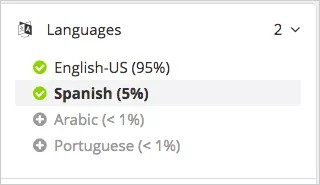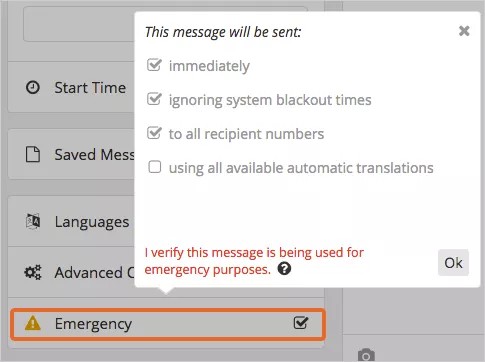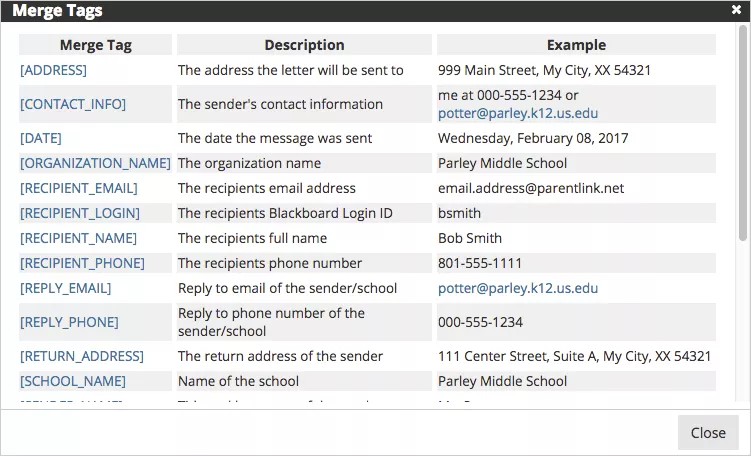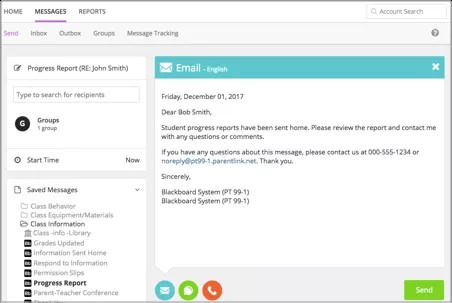Create once - publish everywhere!
You can create and customize messages to send to recipients by phone, email, text, app, and social media. Depending on who you are trying to reach and what your message is, you can select different types of delivery methods (default delivery options can also be pre-set).
Watch the Send Message Interface https://player.vimeo.com/video/123036930 video for a tutorial of sending messages.
Create a message
Senders cannot cancel a message during its delivery, a message can only be canceled 5 minutes before the delivery is set to begin.
- From the Blackboard Communications HQ interface menu, select Messages > Send.
- Type the Subject for the topic of the message.
- Add Recipients, use a Saved Message to resend common messages, change the start time, or adjust many other options.
- Select one or more delivery methods from the main send message page to send to the recipients:
- Template option - Create a template message to be used on all of the delivery types and modified later in each one to customize them. Type the body of the message here. You can also add images for the template option. Not all messages types will post images.
- Phone messages - If you created a template message, the content will be added here for phone calls. You can update the text and select how to make the recording - Call me to record, Call in to record, Upload audio file, Text to speech, or Use microphone. To remove the phone call option, close out the tab from the upper right hand corner.
- Emails - If you created a template message, the content will be added here for emails. You can update the text and add any images. To remove the email option, close out the tab from the upper right hand corner.
- Text/SMS - If you created a template message, the content will be added here for text/SMS messages, but you may need to edit the content to be less than 160 characters. To remove the text/SMS option, close out the tab from the upper right hand corner.
- Mobile App Notifications - For districts and schools that subscribe to Blackboard Mobile Communication app, the content will be added here for the app notifications. You can update the text and add any images. You can also mark the notification to appear only to known recipients and not to the general public of your mobile app. To remove the app notification option, close out the tab from the upper right hand corner.
- Facebook - For districts and schools that subscribe to Blackboard Mass Notifications, Blackboard Mobile Communication app, or Blackboard Social Media Manager, the content will be added here for Facebook messages, but you may need to edit the content to be less than 160 characters. You can update the text and add any images. To remove the Facebook option, close out the tab from the upper right hand corner.
- Twitter - For districts and schools that subscribe to Blackboard Mass Notifications, Blackboard Mobile Communication app, or Blackboard Social Media Manager, the content will be added here for text/SMS messages, but you may need to edit the content to be less than 140 characters. You can update the text and add an image. To remove the Twitter option, close out the tab from the upper right hand corner.
- RSS - For districts and schools that send messages to a third party website, the content will be added here for RSS feeds.
- District/School Websites - For districts and schools that subscribe to Blackboard Web Community Manager and have implemented the Universal Navigation bar, the content will be added here for your district or school websites. You can update the text and add any images. To remove the website option, close out the tab from the upper right hand corner.
- Alerts - For districts and schools that subscribe to Blackboard Web Community Manager and have implemented the Universal Navigation bar, the content will be added here for your district or school website on-screen alerts. You can update the text and select which sites will display the on-screen pop-up alert message. To remove the alert option, close out the tab from the upper right hand corner.
- Include language translations by selecting Add Language, and select each language needed.
You can remove any language with the Delete icon.
Amheric language will not include translation or text-to-speech capabilities. Some Android devices and iOS do NOT support Amheric, and the message may not look correct on those devices. However, it is expected that those users requiring Amheric language will use phones that support the display.
- Set the message as an Emergency if needing to send out immediately.
You can set the message to be sent immediately with the proper language translations.
- Select Send when ready to send the message.
Merge tags with recorded messages
You can use merge tags for recorded phone messages. The tag will record the information available in the database for the specific information.
For example, if you want parents to confirm that their specific child is absent with a phone message, you can record the message, insert a merge tag for the name of the student, and the student's name will be inserted into the generalized recording. Then the message will be sent to all parents of absentee students with the information for their own child.
Merge tags help you to send personalized messages with only one recording.
- In the Advanced Options section, select Use merge tags with recorded audio.
- From the Phone area of the Send Message interface, select Call me to record or Call in to record.
- When typing your script, select your merge tags through the Merge Tags feature. To avoid errors, do NOT copy and paste merge tags into the text.
- Read the script and when you see a merge tag, press the Star (*) button on your phone. Wait for the beep to continue reading your script.
- Press Pound (#) when finished recording, and press 1 to save the message.
Send a saved message
There are several pre-written, standard messages you can use.
- System created: Written and recorded in four supported languages: English, Spanish, Portuguese, and Haitian-Creole. Can't be edited, copied, or deleted. Identified by the Blackboard logo.
- Admin created: Created by your district administrator. Can be copied only. Identified by an image of a building.
- User created: Written and recorded by a user. Can be edited, copied, and deleted. Identified by an image of a person.
Create your own or use system and admin created ones to make common communications easier.
- Select any default or saved messages from the folders in the Saved Messages section. Open each folder to see what default and saved messages are in them.
- If you have permission, update the message or select other delivery methods - Phone, Email, Text/SMS, App Notifications, RSS, Facebook, Twitter, District/School Websites.
- Add Recipients, change the start time, or adjust many other options by using the menu to the left of the message area.
- Include language translations by selecting the Languages.
- Set the message as an Emergency if you need to send it immediately.
- Select Send when ready to send the message.
Search for recipients
Users are able to select recipients by groups, schools, grades, even individually. There are various ways to select recipients.
Use advanced message options
You can adjust how messages are sent — adjust the send time, recipient numbers, and change who is allowed to send this message at another time.
- Select Advanced Options.
- Select the specific district or school from the Sending Organization list.
- Adjust the Delivery Schedule by setting a start date/time, and an end date/time.
- To schedule messages to be sent multiple times, select the Add (+) icon to set multiple dates and times. Use this feature to send reminders to recipients multiple times for an upcoming event.
- Select or clear the remaining options:
- To send a message during blackout times, select Send messages during blackout times.
- To send a message to all numbers available for every user, select Deliver to ALL recipient delivery addresses.
Select Deliver to ALL recipient delivery addresses only during emergencies.
- To send to the parents of selected students, select Deliver to parents of students.
This doesn't send the message to the students, just to the parents of the selected students. If you want to send the message to both parents and students, you have to select both as recipients.
- If you want the header and footer information included in an audio message, clear the Do not play header/footer prompts during outbound calling option. This option is usually checked so that the header and footer information is not included.
- To save this message as public, select Allow other users to also send this message (public).
- If you want recipients respond by pressing 2 from their phones, select Allow message recipients to respond to this message via voice recording.
- If using merge codes for phone messages, select Use merge tags with recorded audio.
- Select Save when finished.
Lag tilgjengelige meldinger
Visste du at det finnes over en milliard mennesker i verden med en fysisk eller psykisk funksjonshemning? Eller at 12,9 % av alle studenter i Nord-Amerika har en eller annen form for funksjonshemning? Det er viktig å sørge for at kommunikasjon forstås av alle studenter og medlemmer av fellesskapet.
Mer om tilgjengelighet i utdanningssektoren
Gode fremgangsmåter for tilgjengelighet for all kommunikasjon
Uansett om det gjelder e-post eller Facebook, blir det lett å gjøre meldinger tilgjengelige for alle med disse anbefalte fremgangsmåtene.
- Skriv på en måte det er lett å forstå. Bruk korte setninger. Bruk ord eller ordkombinasjoner med 1–2 stavelser der det er mulig. Bruk sammentrekninger på engelsk. Bruk verktøy som Hemmingway Editor til å måle lesbarheten av teksten din.
- Ikke bare bruk skriftstiler til å vise hva som er viktig! Hvis du vil gjøre at noe skiller seg ut visuelt, bør du sørge for at du bruker et tilgjengelig alternativ. Bruk for eksempel et utropstegn i slutten av setninger med viktig informasjon. Skjermlesere tar med utropstegn og spørsmålstegn i beregningen. Dette betyr at verktøyet ikke vil lese «spørsmålstegn»—i stedet vil det ha en spørrende tone når det leser et spørsmål høyt.
- Ta med alternativ tekst for bilder. Du trenger ikke å skrive «bilde av», ettersom hjelpeverktøyene allerede vet at det er snakk om bilder. Legg inn en kortfattet, klar og beskrivende tekst. Ikke bruk samme alt-tekst for alle bilder, for eksempel «Bilde som illustrerer den tilknyttede teksten». Det er meningsløst og rotete.
- Legg til bildetekst når du ikke kan bruke alternativ tekst. Hvis du ikke kan legge til alternativ tekst for bilder, bør du sørge for at teksten inneholder all informasjon, og at bildene ikke er nødvendige for å forstå innholdet.
- Gjør lenker beskrivende. Alle lenker bør beskrive hva brukeren kan regne med å finne når han eller hun klikker på dem. Unngå generiske fraser som «klikk her» og «se mer». Nettadresser anses ikke for å være informative og bør ikke brukes. I stedet bør du gjøre slike lenker beskrivende.
- Gjør vedlegg tilgjengelige. Følg samme anbefalte fremgangsmåter for å gjøre vedlegg tilgjengelige. Du finner mer informasjon under Tilgjengelighet hos Blackboard.
- Ta med teksting eller transkripsjoner i videoer. Hvis du mangler teksting for en video, bør du ta med en lenke til en transkripsjon.
- Hør på meldinger for å sikre at de høres riktige ut. De fleste enheter har tekst-til-tale-funksjonalitet, så bruk den for å høre på meldingene dine før du sender dem.
Tilgjengelighet på sosiale medier
Sosiale medier er ikke alltid tilgjengelige for alle brukere. Det er en utfordring for brukere av skjermlesere å navigere i dem, og innhold har ikke alltid overskrifter, alternativ tekst for bilder eller videoteksting. Det betyr imidlertid ikke at du ikke kan bruke sosiale medier. Det er tross alt ofte der brukerne er. Sørg for at innholdet ditt er så tilgjengelig som mulig, for å nå alle brukerne.
Følg de gode fremgangsmåtene for tilgjengelighet for alt innhold, samt disse tipsene når du bruker Facebook eller Twitter.
- Legg inn et tekstalternativ for bilder du publiserer.
- Legg til en lenke til transkripsjoner når du publiserer videoer.
- Fortell brukerne hva Twitter-meldingene dine inneholder. Hvis du publiserer en Twitter-melding med bilder, videoer eller lyd, bør du bruke de følgende prefiksene i starten av meldingen.
- Bilder: [PIC]
- Videoer: [VIDEO]
- Lyd: [AUDIO]
- Plasser eventuelle emneknagger og nevninger i slutten av Twitter-meldingen.
- Bruk både store og små bokstaver i emneknagger. Bruk stor bokstav i starten av hvert ord i emneknaggene. Eksempel: #BlackboardAccessibility
- Unngå tekstsjargong som kan høres rar ut når den leses opp av skjermlesere.
